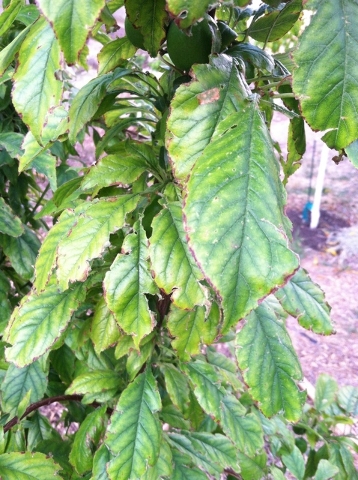Iron problem can cause plum leaves to yellow
Q: I have a 3-year-old Burgundy plum tree. The leaves became yellow in March so I applied KeRex iron to the soil when I first noticed the problem. Now the new leaves do not show any yellow in them, but older leaves are still yellow, so I do not think it is an iron problem.
A: It is still an iron issue. You said the new leaves do not show any yellow. That means your KeRex application in March worked for the leaves that grew after your application.
Iron does not move around inside the tree once the plant takes it up, it goes only into the new growth after the application is made. Growth before the application will still stay yellow.
The only way to correct yellow older leaves is by applying iron spray. This is why applying iron to the soil is so important to make before new growth.
It is not too hot to spray iron on the leaves. It may take four or five sprays a couple of days apart to get all the yellow leaves completely green.
Any iron product, labeled as a spray that’s applied to fruit tree foliage will work. However, I would strongly suggest that any water mixed with this iron fertilizer should be distilled water so that the pH is close to 7, or neutral.
Alternatively, you can adjust the tap water close to neutral using vinegar or another mild acid.
Add a wetting agent to the spray. This helps the iron penetrate the leaf surface and enter the inside of the leaf. Otherwise the spray is not as effective.
Some people use liquid detergents with good success. I worry a little about the other personal care products in liquid detergents, so I would encourage you to use a commercial wetting agent.
You can read more about how to do this on my blog or email me at extremehort@aol.com
Q: My yellow roses were beautiful the first time they bloomed before Easter. However, the flowers aren’t pretty anymore after they open. The flower looks burned on the edges of the petals. I haven’t seen bugs on the flowers. Otherwise the plant looks healthy to me.
A: Your roses, from the sound of it, are probably infested with Western flower thrips. These tiny insects are nearly impossible to see unless you use a magnifying glass and inspect the flowers closely. They are also difficult to control.
This is the same insect that causes nectarine fruit to scar.
Thrips are poor fliers and so stay close to the plants they feed upon. They have mouth parts that shred tender plant parts such as flower petals and flower buds before or after they open. The flower petals appear damaged and with streaks of brown.
Soap and water sprays are somewhat effective but the best spray for controlling this insect contains spinosad.
Dormant sprays of horticultural oil during the winter and applied before the plant starts growing will also help.
I would alternate sprays between an insecticidal soap such as Safer’s and spinosad sprays until you get some control.
Q: I was told by the Nevada Department of Agriculture the tiny insects I found jumping around in my bathroom were springtails. I have read they are very hard to kill, which I am finding out after I had an exterminator try to get rid of them.
A: Insecticides are not a good choice for controlling springtails. It usually requires several repeat applications of traditional household insecticides and they will return if the source of the problem is not corrected.
Springtails are tiny jumping insects, about 1/16 inch long, that are found in cooler times of the year where there is standing water. I have seen them here outside in grass that is kept too wet or where there is a water leak.
Because they are such good jumpers, they are sometimes confused with leafhoppers outside the home and fleas inside the home. They are neither.
Inside the house, they can multiply where the flooring is kept constantly moist. They feed off mold and fungi that grow where there is shallow, standing water or on very wet soils. If the area is kept dry and clean, they’ll disappear.
Save your money. Don’t apply pesticides. Fix the area so it stays dry and sanitize it.
Q: I know you recommend bark mulches around trees to help in water retention. However, there are negatives to consider, such as cockroaches, bugs, etc. I encounter lots of cockroaches in the ground when I have excavated in certain areas of our yard.
A: I encourage the use of wood mulches more than bark mulches. Bark mulches seldom decompose much and add very little value to the soil; they are purely decorative. Wood mulches decompose relatively quickly in moist soils and add a lot of value to desert soils.
You are absolutely right. Insects such as cockroaches are scavengers. Like many insects they like two things: water and a food source. This is why you frequently see tons of them inside irrigation boxes.
They feed on plants and animal life that have died and help in its decomposition. Feeding on dead and animal life helps return organic life back to the soil.
Cockroaches do not discriminate between food and water inside the home or outside the home. They will enter the home if given the opportunity.
Using a foundation spray applied around the perimeter of the home and in valve boxes helps keep these critters from entering the home. Foundation sprays are insecticide barriers applied to the outside of the home at soil level and 12 inches above the soil.
A good time to make this application is when temperatures begin to cool in the fall.
Bob Morris is a horticulture expert living in Las Vegas and professor emeritus for the University of Nevada. Visit his blog at xtremehorticulture.blogspot.com. Send questions to Extremehort@aol.com.


















